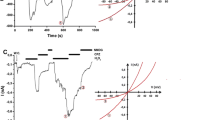Abstract
Using a patch-clamp technique in the whole-cell configuration, we studied the effect of an exogenous antioxidant, dithiothreitol (DTT), on transmembrane currents in isolated cells obtained from the rat spinal ganglia. We demonstrated that this antioxidant (DTT) is capable of modulating the proton-gated current. In most neurons, proton-gated currents increased in the presence of the antioxidant. Since proton-gated receptor-channel complexes of sensory neurons are involved in different processes of signalling and transmission of sensory information in the peripheral nervous system, we hypothesize that the influences mediated by alterations of the concentrations of antioxidants participate in the formation of the state of algesia under normal physiological conditions and of that of hyperalgesia in pathological states. In addition, oxidative stress, which causes a shift in the balance of concentrations of antioxidants, accompanies numerous abnormal pathophysiological states, in particular diabetes, ischemia, and inflammation. Since proton-gated channels are permeable for calcium ions, an antioxidant-induced increase in calcium signalling can be significantly important for a number of biochemical processes occurring in tissues.
Similar content being viewed by others
References
O. A. Krishtal and V. I. Pidoplichko, “A receptor for protons in the nerve cell membrane,” Neuroscience, 5, 2325–2327 (1980).
M. Paukert, S. Sidi, C. Russell, et al., “A family of acid-sensing ion channels from the zebrafish: widespread expression in the central nervous system suggests a conserved role in neuronal communication,” J. Biol. Chem., 279, 18783–18791 (2004).
B. M. Lomaestro and M. Malone, “Glutathione in health and disease: pharmacotherapeutic issues,” Ann. Pharmacother., 29, 1263–1273 (1995).
L. Ghibelli, C. Fanelli, G. Rotilio, et al., “Rescue of cells from apoptosis by inhibition of active GSH extrusion,” FASEB J., 12, 479–486 (1998).
E. Lingueglia, J. R. de Weille, F. Bassilana, et al., “A modulatory subunit of acid-sensing ion channels in brain and dorsal root ganglion cells,” J. Biol. Chem., 272, 29778–29783 (1997).
W. Retz, W. Gsell, G. Munch, et al., “Free radicals in Alzheimer’s disease,” J. Neural. Transm., Suppl., 54, 221–236 (1998).
E. Sofic, K. W. Lange, K. Jellinger, et al., “Reduced and oxidized glutathione in the substantia nigra of patients with Parkinson’s disease,” Neurosci. Lett., 142, 128–130 (1992).
M. A. Carai, G. Vacca, S. Serra, et al., “Suppression of GABA(B) receptor function in vivo by disulfide reducing agent, DL-dithiothreitol (DTT),” Psychopharmacology, 174, 283–290 (2004).
A. Omerovic, J. P. Leonard, and S. R. Kelso, “Effects of nitroprusside and redox reagents on NMDA receptors expressed in Xenopus oocytes,” Brain Res. Mol./Brain Res., 22, 89–96 (1994).
R. Waldmann, G. Champigny, F. Bassilana, et al., “Molecular cloning and functional expression of a novel amiloride-sensitive Na+ channel,” J. Biol. Chem., 270, 27411–27414 (1995).
N. J. Allen and D. Attwell, “Modulation of ASIC channels in rat cerebellar Purkinje neurons by ischaemia-related signals,” J. Physiol., 543, 521–529 (2002).
I. Chizhmakov, Y. Yudin, N. Mamenko, et al., “Opioids inhibit purinergic nociceptors in the sensory neurons and fibers of rat via a G protein-dependent mechanism,” Neuropharmacology, 48, 639–647 (2005).
V. I. Pidoplichko, “Two different tetrodotoxin-separable inward sodium currents in the membrane of isolated cardiomyocytes,” Gen. Physiol. Biophys., 5, 593–604 (1986).
L. H. Tang and E. Aizenman, “Long-lasting modification of the N-methyl-D-aspartate receptor channel by a voltage-dependent sulfhydryl redox process,” Mol. Pharmacol., 44, 473–478 (1993).
P. Zhang and C. M. Canessa, “Single channel properties of rat acid-sensitive ion channel-1alpha,-2a, and-3 expressed in Xenopus oocytes,” J. Gen. Physiol., 120, 553–566 (2002).
P. Zhang and C. M. Canessa, “Single-channel properties of recombinant acid-sensitive ion channels formed by the subunits ASIC2 and ASIC3 from dorsal root ganglion neurons expressed in Xenopus oocytes,” J. Gen. Physiol., 117, 563–572 (2001).
R. Waldmann, G. Champigny, F. Bassilana, et al., “A proton-gated cation channel involved in acid sensing,” Nature, 386, 173–177 (1997).
E. L. Bassler, T. J. Ngo-Anh, H. S. Geisler, et al., “Molecular and functional characterization of acid-sensing ion channel (ASIC) 1b,” J. Biol. Chem., 276, 33782–33787 (2001).
A. A. Starkov, C. Chinopoulos, and G. Fiskum, “Mitochondrial calcium and oxidative stress as mediators of ischemic brain injury,” Cell Calcium, 36, 257–264 (2004).
D. S. Warner, H. Sheng, and I. Batinic-Haberle, “Oxidants, antioxidants and the ischemic brain, ” J. Exp. Biol., 207, 3221–3231 (2004).
K. V. Ambrozaitis, E. Kontautas, B. Spakauskas, et al., “Pathophysiology of acute spinal cord injury,” Medicina, 42, 255–261 (2006).
Author information
Authors and Affiliations
Corresponding author
Additional information
Neirofiziologiya/Neurophysiology, Vol. 38, No. 3, pp. 193–197, May–June, 2006.
Rights and permissions
About this article
Cite this article
Fedorenko, A.L., Lozovaya, N.A., Volkova, T.M. et al. Antioxidant-caused changes in the permeability of proton-gated ion channels for sodium and calcium. Neurophysiology 38, 158–162 (2006). https://doi.org/10.1007/s11062-006-0039-5
Received:
Issue Date:
DOI: https://doi.org/10.1007/s11062-006-0039-5




